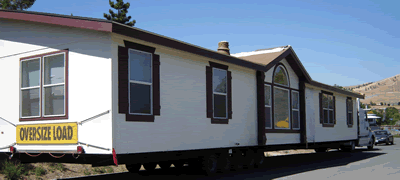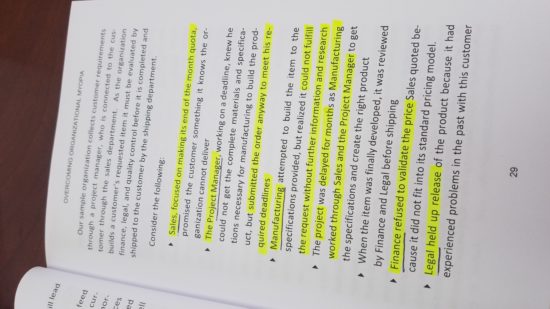What does moving a manufactured home have to do with silos? In our case everything!
This story has become the poster child for my book, Overcoming Organizational Myopia!
My wife and I purchased a manufactured home for our horse property. There are actually quite a few moving parts to buying a double wide. One would expect these people to be experts at this.
The problem — silos creating organizational myopia.
It’s so bad, I, as a customer, can see every issue with these companies as plain as day.
First, let’s examine the major silos at work here:
1. Dealership. They are made up of three silos: 1) Sales – the people who sell the product; 2) Finance – the person who completes the formal paperwork; and 3) Project Manager – the person who is supposed to manage the delivery and setup of the home.
2. Factory. The Dealership and Factory are the same company. I see three silos: 1) Constuction – builds the home; 2) Maintenance – responsible for setup and warranty work; and 3) Trim Out – contracted company that finishes out the inside of the home onsite.
3. Delivery and Setup. Although used as a local contractor by all the dealers, they are a subcontractor that does site prep, delivery, setup, hook-up, and special stuff, like decks and skirting. As far as I can see, as a customer, they have at least seven silos, but they actually have silos within silos. The first silo is the Project Manager – this one guy is terrible, so bad in fact, I didn’t even know he was out PM for this effort. The first person we dealt with, forms a second silo. I’m not sure what to call him, but he’s kind of like Sales, but he was the first person who surveyed the site, determined requirements, and put together the bid. Of course, they have a Finance silo – one single person to take your money (everyone has one of these). Then, you have the Site Prep silo, Delivery silo, Setup silo, and Utilities silo. The Setup silo uses subcontractors and each of them (we dealt with three, that do the same job) are their own silo. I suspect there is at least one moresolo, made up of subcontractors, that handle the siding and decks, but haven’t dealt with them yet.
If you have read my book, I’m sure you can already see where the myopia might form. Let me tell you, it’s been pretty obvious working with this effort.
Myopia Issue #1. Dealership makes promises, yet financial paperwork is different. Here’s how you know you’re dealing with myopia. We signed an agreement with the salesperson. When we go to signing the 1,000 pages of documents, what we agreed to is not reflected in the paperwork. Comment, “Oh, I didn’t know that. I’ll have to check with the salesperson.” Impact: wasting company’s and customer’s valuable time at signing, getting with salesperson, validating what was written down and agreed to, and redoing paperwork to sign.
Myopia Issue #2. Dealership Project Manager only cares about getting the house built and delivered. While it’s being built and delivered, its costing them money. After it’s delivered, it’s someone else’s problem. Even though, they should ensure the customer’s end-to-end experience is flawless. Impact: Customer has to deal with several people across the three major silos to actually move into their new home.
Myopia Issue #3 — Everything After the Sale. Since the Dealership PM only cares about getting the product off their books, they dump the effort at that point. Now, I, as the customer, am forced to deal with all the silos related to the Factory and the Delivery and Setup subcontractor. This is where it really gets UGLY!
With the Delivery and Setup silo, two major myopia issues impact this company and resulted in a big fat 0 for customer satisfaction! First was a PM that is totally clueless. This guy didn’t just drop the ball; he lost it under the bleachers. The PM was so bad, that we didn’t even know he was our PM. Impact: Customer (that’s me) acts as PM and spends hours working with every silo in the company! The second major myopia issue is Communication (or, the Lack There Of). Since, I’m the PM on this effort, I worked with every single silo. In every interation the silos complain about and/or demonstrate a complete lack of communication across the company. Impacts: Project delays, constant defects, and unhappy customer.
Since the Dealership PM drops the effort after delivery, the other major silo we are forced to work with is the Factory. So far, it’s been the finishing effort on property. Their major issue is a lack of end-to-end process ownership. How this manifested itself is as follows. The finishing crew comes out to basically Make Ready the home for move in. They have to close up the two halves of the house, fix all the damage from moving, and repair stuff the Construction silo screws up. This was a constant game of Passing the Blame. These guys passed so many bucks that they’re horribly in debt! They blamed everything on the Delivery and Setup and Factory silos, so essentially they could get out of doing tons of work. Impacts: Work left no lt completed, more delays, and tons of rework by “warranty.”
Now, just think…they haven’t even finished the setup of this home and we have yet to move in. Consider this timeline so far. Its May 14th. On April 1st, we closed on the sale of our other home. On April 4th, we agreed on the purchase of this home. On April 8th, we closed on the purchase (paid cash). On April 15th, the house was ready (it was already being built when purchased). It wasn’t delivered until April 29th! It’s now May 14th and yesterday they “finished” the finish work after passing off unfinished work. Also, no utilities have been hooked up and we don’t even know when that might happen.
Leaders…Take a look at your operation. Is this what you see? You have silos in your company…they are inevitable and you actually want them … no, you need them to operate! However, it’s the myopic behavior, as demonstrated here, that forms out of silos gone wrong.
Need help identifying the silos and the myopia? I’m an expert at it. Every business you deal with throughout the day has these issues.
I hope this helps you better “see” how silos exist, organizational myopia occurs, and what its impact is like.


